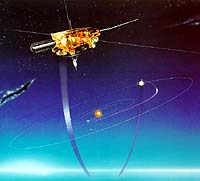| . |  |
. |
 Ulysses Ready For Hot Solar Polar Adventure
Ulysses Ready For Hot Solar Polar AdventureParis - February 7, 2000 - Ulysses, the joint ESA/NASA spacecraft to explore the region of space above the Sun's poles, is poised on the edge of new discoveries as it prepares to pass over the poles of the Sun for the second time in its ten year lifetime. The first passage occurred at solar minimum, a time of low solar activity. But the second will occur at solar maximum when the Sun is at its most turbulent. New findings are expected about the effects of this turbulence on the heliosphere, the vast volume of space that engulfs all the planets and over which the Sun exerts its influence. The spacecraft is now 43 deg south at a distance of 613 million km from the Sun. It will pass over the south pole (above 7 deg S) between 8 September 2000 - 16 January 2001 and will then travel on the short leg of its orbit to reach the north pole about a year later (3 September - 12 December 2001). The south polar passage is expected to occur very close to solar maximum, when the number of sunspots visible on the Sun's surface is at a peak. The passage over the north pole will occur when the Sun and heliosphere are adjusting to the changes the maximum brought about. Changes in the Sun's magnetic field drive the solar cycle, which oscillates between maximum and minimum once every 11 years. As solar maximum approaches, magnetic turmoil builds up within the Sun. "From below the surface, magnetic fields emerge in a more disorganised way than at solar minimum. This makes the solar corona (the Sun's atmosphere) far more of a tangle of magnetic loops," says Andre Balogh, of Imperial College, London and Principal Investigator on the magnetometer experiment on board Ulysses. The magnetic field lines seem to pull escaping corona back into the Sun's surface, giving the corona the appearance of "a daisy with loops for petals," says Balogh. One consequence of this increased magnetic complexity will be more solar storms and coronal mass ejections, when the Sun spits out large volumes of coronal matter into the heliosphere. These can have devastating effects on communications and power systems on Earth. Ulysses will measure the effects of the turbulence on the heliosphere, which is created by the stream of charged particles (solar wind) that the Sun blows out into space. At solar maximum, the polarity of the Sun's magnetic field changes. Balogh explains: "At solar minimum, the Sun is almost like a bar magnet with a north and a south pole. As the Sun reaches its maximum activity, new magnetic fields bubble up from below the surface and it's no longer like a bar magnet. "But once solar maximum is over, and the Sun quietens down, the magnetic polarities return to the poles, but in reverse: the north magnetic pole has become the south magnetic pole and vice versa. Eleven years later, the same thing happens again," said Balogh. The transition occurs during a 12-18 month period after solar activity has peaked. "Quite fortuitously, Ulysses will begin to travel over the Sun's south pole next September, just as the Sun's activity is expected to peak. By the time it reaches the north pole, a year later, the magnetic polarity may well have flipped," says Richard Marsden, Ulysses project scientist at ESA's technical centre, ESTEC, in the Netherlands. "But the Sun is known to be fickle and the exact timing of these events is uncertain. Whatever the timing, it will take many months before the heliosphere fully adjusts to having been turned upside down, magnetically speaking," said Marsden. Plans are therefore being laid for Ulysses to operate for several years beyond solar maximum to allow a clear picture to form of the behaviour of the heliosphere over a complete solar cycle.
SPACE SCIENCE
|
| |||||||||
| The content herein, unless otherwise known to be public domain, are Copyright 1995-2016 - Space Media Network. All websites are published in Australia and are solely subject to Australian law and governed by Fair Use principals for news reporting and research purposes. AFP, UPI and IANS news wire stories are copyright Agence France-Presse, United Press International and Indo-Asia News Service. ESA news reports are copyright European Space Agency. All NASA sourced material is public domain. Additional copyrights may apply in whole or part to other bona fide parties. Advertising does not imply endorsement, agreement or approval of any opinions, statements or information provided by Space Media Network on any Web page published or hosted by Space Media Network. Privacy Statement All images and articles appearing on Space Media Network have been edited or digitally altered in some way. Any requests to remove copyright material will be acted upon in a timely and appropriate manner. Any attempt to extort money from Space Media Network will be ignored and reported to Australian Law Enforcement Agencies as a potential case of financial fraud involving the use of a telephonic carriage device or postal service. |